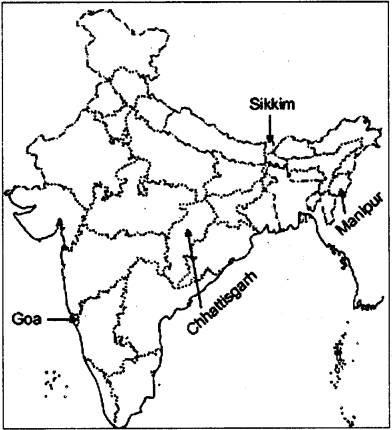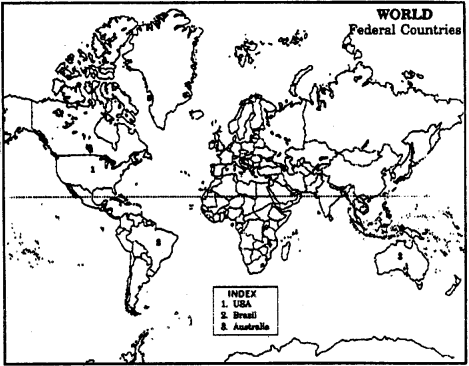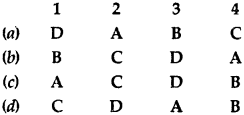NCERT Solutions for Class 10 Social Science Civics Chapter 2 Federalism
Textbook Exercises
Question 1.
Locate the following states on a blank outline political map of India: Manipur, Sikkim, Chhattisgarh and Goa.
Answer:

Question 2.
Identify and shade three federal countries further than India on a blank outline political map of the world.
Answer:

Question 3.
Point out one feature in practice of federalism in India that is similar to and one feature that is different from that of Belgium.
Answer:
Similar Feature :
Just like Belgian constitution, Indian -constitution clearly provided distribution of legislative powers between the Union Government and the State Governments. The State governments are not subordinate to the Central government.
Different Feature:
In Belgium, apart from the Central and the State Government, there is a third kind of government, known as Community Government . This community government is elected by people belonging to one language community-Dutch, French and German speaking- no matter where they live. This government has the power regarding cultural, educational and language related issues In India, there in no such provision, the power has been decentralized with the introduction of the system of Local Self Government.
Question 4.
What is the main difference between a federal form of government and a unitary one? Explain with an example.
Answer:
| Federal Government | Unitary Government |
| 1. Federalism is a system of government in which the power is divided between a central authority and various constituent units of the country, | 1. Under unitary system, either there is only one level of government or the sub- units are subordinate to the central government. |
| 2. In a federal system, the central government cannot order the state government to do something. | 2. The centra! government can pass on orders to the provincial or the local government in a unitary system. |
| 3. State government has powers of its own for which it is not answerable to the central government. | 3. In a unitary system, state governments get their powers from the central government and they are answerable to the central government for their actions. |
Question 5.
State any two differences between the local government before and after the Constitutional amendment in 1992.
Answer:
(a) Before 1992:
(i) Before 1992 the Panchayats in villages and municipalities in urban areas were directly under the control of state governments.
(ii) Elections to these local governments were not held regular and the local governments did not have any powers or resources of their own.
(b) After the constitutional amendment in 1992 :
(i) Now it is constitutionally mandatory to hold regular elections to the local government bodies.
(ii) The State governments are required to share some powers and revenue with local government bodies
Question 6.
Fill in the blanks:
Since the United States is a ………. type of federation all the constituent States have equal powers and States are …………… visa-vis the federal government. But India is a …………… type of federation and some States have more power than others. In India the ………… government has more powers.
Answer:
Coming together; Strong: Holding together: Central
Question 7.
Here are three reactions to the language policy followed in India. Give an argument and an example to support any of these positions.
Sangeeta : The policy of accommodation has strengthened national unity.
Arman : Language based states has divided us by making everyone conscious of their language
Harish : This policy has only helped to consolidate the dominance of English over all other languages.
Answer:
We agree with the argument produced by Sangeeta that the policy of accommodation has strengthened national unity. In our country Hindi has been declared as official language. But Hindi is the mother tongue of only about 40 per cent of Indians. So, there are 21 other languages recognized as Scheduled Languages by the Arman Harish Constitution. States too have their own official languages. Much of the government work takes place is the official language of the concerned state. Secondly, a candidate in an examination conducted for the national government positions may opt to take the examination in any of the Scheduled languages.
Question 8.
The distinguishing feature of a federal government is:
(a) National government gives some powers to the provincial government.
(b) Power is distributed among the legislature, executive, and judiciary.
(c) Elected officials exercise supreme power in the government
(d) Governmental power is divided between diffetent levels of government.
Answer:
(d) Governmental power is divided between diffetent levels of government.
Question 9.
A few subjects in various Lists of the Indian Constitution are given here. Group them under the Union, State and Concurrent Lists as provided in the table below
A. Defence; B. Police; C. Agriculture; D. Education ; E. Banking : Forests; G. Communications: H Trade; I. Marriages
Union List
State List
Answer:
| Union List | Defence, Banking Communication |
| State List | Police, Agriculture, Trade |
| Concurrent List | Education, Forest, Marriages. |
Question 10.
Examine following pairs that give the government in India and the powers of the government at that level to make laws on the subjects mentioned against each. Which of the following pairs is not correctly matched?
| (a) State Government | State List |
| (b) Central Government | Union List |
| (c) Central and State Government | Concurrent List |
| (d) Local Government | Residuary powers |
Answer:
(d) Local government : Residuary powers is not correctly matched.
Question 11.
Match List I with List II and select the correct answer using the codes given below the lists:
| List I | List II |
| 1. Union of India | A. Prime Minister |
| 2. State | B. Sarpanch |
| 3. Municipal Corporation | C. Governor |
| 4. GramPanchyat | D. Mayor |

Answer:
![]()
Question 12.
Consider the following two statements.
(A) In a federation the powers of the federal and provincial governments are clearly demarcated.
(B) India is a federation because the powers of the Union and State governments are specified in the Constitution and they have exclusive jurisdiction on their respective subjects.
(C) Sri Lanka is a federation because the country is divided into provinces.
(D) India is no longer a federation because some powers the states have been devolved to the local government bodies. Which of the statements given above are correct?
(a) A, B and C
(b) A, C and D
(c) A and B only
(d) B and C only
Answer:
(c) A and B only
These Solutions are part of NCERT Solutions for Class 10 Social Science. Here we have given NCERT Solutions for Class 10 Social Science Civics Chapter 2 Federalism.